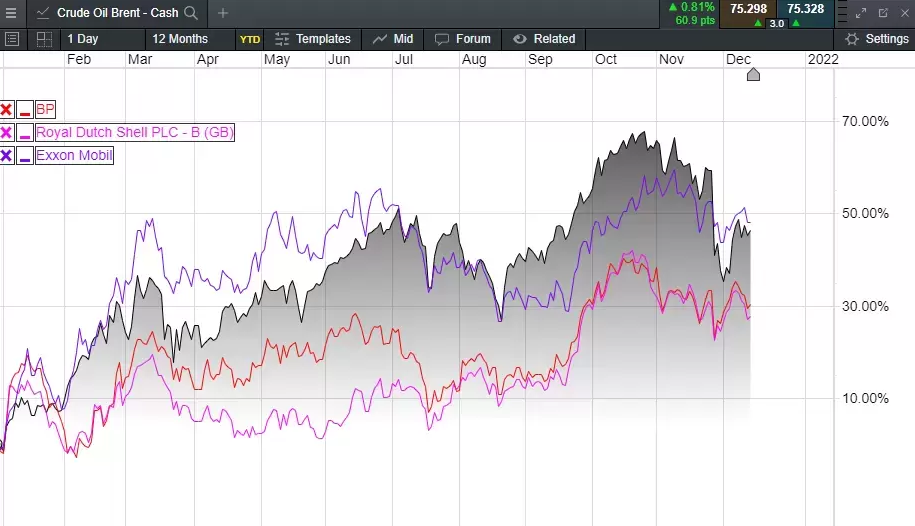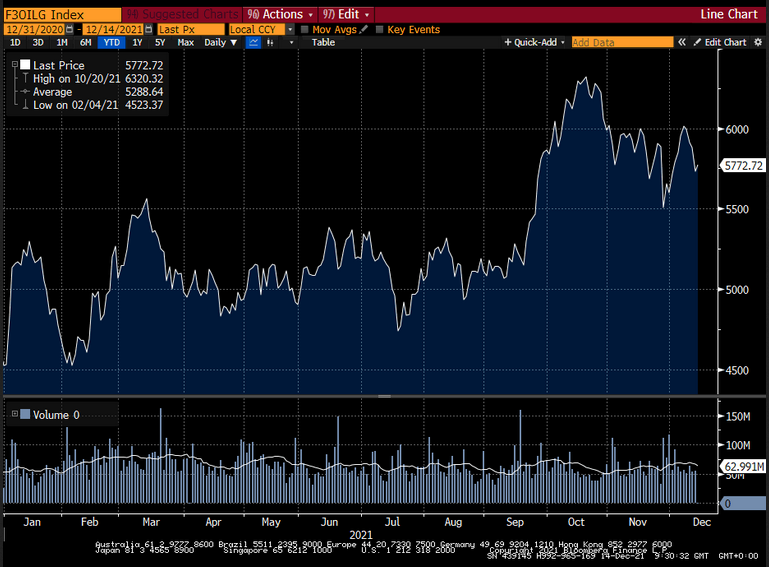If 2020 was the year the oil and gas industry almost imploded, then 2021 has been the year that has seen an almost Lazarus like comeback, although the big oil companies still face the same problems they had heading into the pandemic.
The collapse in prices that we saw in 2020 may well have been pandemic related, but it certainly wasn’t helped by the price war between Saudi Arabia and Russia that broke out just prior to the lockdowns. This additional factor helped exacerbated the sell-off in prices that saw US futures prices go briefly negative, as well as prompting the collapse in a whole host of US shale businesses, and the cancellation of a number of new pipelines.
In a belated effort to contain the meltdown in prices, as well as protect their own balance sheets OPEC scrambled to support prices by slashing oil production output to as low as 22.5m barrels a day in June 2020, and well below the levels of 32.9m barrels a day that were being pumped out in October 2018, as brent crude prices bottomed at about $15 a barrel during April 2020
Since that day, Russia also saw its output decline in 2020 from a peak of just over 11.3m barrels a day, to a low of just below 9m, before undergoing a steady recovery to levels just above 10m now, according to the EIA.
Having been horribly burned in the early part of 2020 it would appear that neither OPEC or Russia wants to repeat the mistake that saw the oversupply and price collapse that we saw 20 months ago, as refinery and oil storage capacity almost ran out.
With oil prices now back above $80 a barrel they now appear to be compensating for that mistake in the opposite direction, with a reluctance to overly relax their hands on the tiller when it comes to restoring the output that was cut back in response to last year’s sudden demand stop.
Currently OPEC is increasing output by 400k barrels a day on an incremental basis, month on month, with daily output now back close to 30m barrels a day, amidst concerns that they are going too slowly as inventory levels run low.
US crude oil production also underwent a sharp slowdown slipping from 12.8m barrels a day to a low of 9.7m in May 2020. Output is now back at around 11.1m barrels a day according to the EIA.
While the price and demand collapse dented the balance sheets of the oil producing countries it also did immense damage to the balance sheets of the big oil major companies, losing as they did a combined $76bn between them. Around $70bn of that amount was as a result of write-downs and impairments on unviable or stranded assets, however the challenge for the likes of Exxon Mobil (NYSE:XOM), BP (LON:BP) and Royal Dutch Shell (LON:RDSa) remains in how they transition towards a renewable future without hammering their margins.
Since those dark days in 2020 when we saw the share prices of the big major companies lose over 40% of their market cap, we’ve seen a fairly decent recovery, although most of the same questions remain.
YTD - Oil price relative to share price performance of BP, Shell, and Exxon

Source: CMC Markets
As we can see from the above graphic, we’ve seen a decent rebound in the share price of the oil majors although it is notable that both BP and Royal Dutch Shell have lagged despite the surge in not only the oil price, but also in natural gas prices as well, which have hit record highs in Europe, and 7-year highs in the US.
This is disappointing especially when you consider that we’ve rebounded from share price levels last seen in the 1990’s, and that we’ve seen both BP and Royal Dutch Shell restart their dividends as well as share buybacks.
The oil and gas sector has been one of the FTSE100 outperformers this year as can be seen from the chart below:

Source: Bloomberg
So how have BP and Shell managed their recovery process this year? It is certainly welcome that the rebound in oil and gas prices has helped boost the balance sheets of both businesses.
In 2020 BP was eventually forced to bow to the inevitable and cut its dividend to 5.25c a share, as well as announcing swingeing job cuts
Now as we look back on the last 12 months one has to assess whether BP and Shell are doing enough to help with the transition towards renewables without hammering the very margins that allow them to return loads of cash to their shareholders.
Both companies are already coming under pressure from an increasingly boisterous green lobby, as well as ESG investors to be more environmentally friendly, and become carbon neutral by the end of the decade.
If we look at how BP has done this year, there has been progress on the balance sheet, as well as the debt levels, with debt now down to $31.97bn, in the latest Q3 numbers, down from $32.7bn in H1, and well below the target of $35bn set at the start of this year.
Even so, the business still has some way to go before it gets to a place where its reliance on crude oil and natural gas becomes less important, with capex still low relative to its peers at $9.2bn year to date.
The company also increased its dividend to 5.46c a share, as well as announcing a $1.4bn share buyback from its H1 surplus cash flow, while also saying that with oil prices at $60 there was scope to deliver buybacks of $1bn a quarter, and to have capacity to increase the dividend by 4%.
While this is all good news for shareholders in the short term, and the rest of this year likely to be a decent one when it comes to the current level of oil and natural gas prices, a fact acknowledged in BP’s Q4 outlook, with the gas regions expected to contribute strongly on higher demand, the jury remains out on how long the business can enjoy the levels of cashflow fossil fuels afford them.
Demand is likely to hold up into the winter months, however management needs to have a plan other than returning cash to shareholders, especially with the green lobby breathing down its neck to cut emissions faster.
The company can talk about “Performing while Transforming” all it likes but it needs to prove to shareholders and the markets that it can transition to renewables in a way that doesn’t hammer its margins, and the jury is likely to remain out on that for a while, although one thing in its favour is that the lack of incentives to invest in new fossil fuel sources is likely to keep upward pressure on prices.
Royal Dutch Shell is in a similar position, with the rebound in oil and gas prices helping its fiscal position, however a disappointing Q3 update has prompted calls for the company’s break up from activist shareholder Dan Loeb’s Third Point Group.
This appears to have come about from frustration amongst some shareholders with respect to the underperformance of the business, with the argument being that Shell is trying to serve two masters and that you can’t be all things to all people. While that is true, it’s also a truism of life in general and shouldn’t be a rationale for breaking up the company into its legacy business, and into a renewables and marketing unit.
The problem with this argument is that the legacy business needs to fund the transition to renewables so there inevitably needs to be an element of cross over between the two.
As far as buybacks and dividends are concerned Shell also appears to be going down a similar route to BP. In September Shell sold its Permian Basin business to ConocoPhillips (NYSE:COP) for $9.5bn, promising to return $7bn to shareholders, and pay down its debt which fell to $57.5bn.
While shareholders will no doubt be pleased to receive another cash windfall it also appears that management are repeating the same mistakes of the past.
By all means return funds to shareholders, but the focus on shareholder returns, allied with the low levels of investment in the transition to renewables points to a lack of seriousness when it comes to transitioning the business.
The transition to renewables is not a light switch which you can simply switch on. It needs a clear plan with the revenue generated by its LNG and oil business helping it to transition towards the lower margin business of renewable energy.
While both companies say they are committed to cutting emissions, they are still running high levels of debt, while at the same time as returning huge amounts of cash to shareholders, which could probably be better spent elsewhere.
They also have the added wrinkle of falling foul of so-called ESG investors who will be encouraged to shun the shares. That shouldn’t be a problem in the short term.
Oil and gas demand is likely to remain high for a while yet, and for all the cant and hypocrisy of some of the narrative vilifying oil companies, they remain key parts of the global economy, given that oil and petroleum by-products are used in all manner of day to products, including clothing, tyres, car parts, and everyday items.
This should mean that while they remain in the crosshairs of the green lobby that the dividend is unlikely to be cut, assuming oil and gas prices stay roughly where they are which seems likely given the lack of investment in new oil and gas sources.
In the short term they need to get their debt levels down, at the same time as showing they are part of the solution, something they appear to be struggling with now.
BP is starting to spend more on renewables, albeit from a low base, but will need to spend a lot more if it wants to reach its highly ambitious target of 50GW by 2030. At the end of 2020 its current figure stood at 2.5GW.
By comparison, Orsted (CSE:ORSTED), which is one of the world’s biggest providers of renewable energy of offshore wind, currently has a total of 12GW of installed capacity, which it is expected to increase to 50GW by 2030, by a combination of wind, solar and renewable hydrogen, at a cost of DKK350bn, or about $54bn.
On that basis BP and Shell have a long way to go.
"DISCLAIMER: CMC Markets is an execution only provider. The material (whether or not it states any opinions) is for general information purposes only, and does not take into account your personal circumstances or objectives. Nothing in this material is (or should be considered to be) financial, investment or other advice on which reliance should be placed.
No opinion given in the material constitutes a recommendation by CMC Markets or the author that any particular investment, security, transaction or investment strategy is suitable for any specific person. "
